Designing and Deploying Microsoft Exchange Server 2016 Outline/2019 M20345-2 Course Outline
Module 1: Planning Exchange Server Deployments
- New features in Exchange Server 2019.
- Gathering Business Requirements for an Exchange Server Deployment.
- Planning for an Exchange Server Deployment.
- Planning the Migration of Unified Messaging to Cloud Voicemail.
Lab: Planning Exchange Server 2019 Deployments
- Evaluating an Existing Messaging Infrastructure.
- Identifying Requirements.
- Discussion: Deployment Design for Exchange Server 2019.
Module 2: Planning and Deploying Exchange Server Mailbox Services
- Planning Exchange Server Hardware Requirements.
- Planning Exchange Server for Virtualisation and Microsoft Azure Integration.
- Planning and Implementing Public Folders.
Lab: Planning and Implementing Exchange Server Mailbox Servers, Databases, and Public Folders
- Planning Mailbox Server Configuration and Location.
- Planning for Mailbox Databases.
- Implementing Mailbox Databases.
- Planning and Implementing Public Folders.
Module 3: Planning Message Transport
- Designing Message Routing.
- Designing Transport Services.
- Designing the Message-Routing Perimeter.
- Designing Transport Compliance.
Lab: Planning Message Transport
- Planning for a Redundant and Secure Message Transport.
- Planning for Transport Compliance.
- Implementing Transport Compliance.
Module 4: Planning and Deploying Client Access
- Planning for Exchange Server Clients.
- Planning for Client Access.
- Planning and Implementing Office Online Server.
- Planning and Implementing Coexistence of SharePoint 2019 with Exchange Server 2019.
- Designing external client access.
Lab: Planning and Deploying Client Access Solutions
- Planning and Configuring Namespaces.
- Planning and Configuring Client Access Services Options.
- Planning and Deploying Office Online Server.
- Planning and Implementing Reverse Proxy.
Module 5: Designing and Implementing High Availability
- Planning High Availability for Exchange Server.
- Planning for Load Balancing.
- Planning for Site Resilience.
Lab: Designing and Implementing High Availability
- Planning High Availability and Site Resilience.
- Creating a Site-Resilient DAG.
- Validating Site Resilience.
- Creating a Lagged Database Copy.
- Recovering Data from a Lagged Database Copy.
Module 6: Maintaining Exchange Server
- Using Managed Availability to Improve High Availability.
- Implementing DSC.
Lab: Maintaining Exchange Server
- Using Windows PowerShell to Investigate and Configure Managed Availability.
- Implementing DSC.
Module 7: Designing Messaging Security
- Planning Messaging Security.
- Designing and Implementing AD RMS and Azure RMS.
Lab: Designing Messaging Security
- Planning Messaging Security.
- Implementing AD RMS.
- Integrating AD RMS with Exchange Server.
- Creating a Message Transport Rule to Protect Email.
Module 8: Designing and Implementing Message Retention and Archiving
- Overview of Archiving and Messaging Records Management.
- Designing In-Place Archiving.
- Designing and Implementing Message Retention.
Lab: Designing and Implementing Message Retention and Archiving
- Designing Message Retention and Archiving.
- Implementing Message Retention and Archiving.
Module 9: Designing and Implementing Messaging Compliance
- Designing and Implementing Data Loss Prevention Policies.
- Designing and Implementing In-Place Hold.
- Designing and Implementing In-Place eDiscovery.
Lab: Designing and Implementing Messaging Compliance
- Designing Messaging Compliance.
- Implementing Data Loss Prevention.
- Implementing In-Place eDiscovery.
- Comparing Messaging Policy and Compliance Options.
Module 10: Designing and Implementing Messaging Coexistence
- Designing and Implementing Federation.
- Designing Coexistence between Exchange Organisations.
- Designing and Implementing Cross-Forest Mailbox Moves.
Lab: Implementing Messaging Coexistence
- Implementing Message-Routing Coexistence.
- Migrating User Mailboxes.
Module 11: Upgrading to Exchange Server 2019
- Planning an Upgrade from Previous Exchange Server Versions.
- Implementing the Upgrade from Previous Exchange Server Versions.
Lab: Upgrading from Exchange Server 2013 to Exchange Server 2019
- Documenting the Exchange Server 2013 Organisation.
- Deploying Exchange Server 2019.
- Upgrading from Exchange Server 2013 to Exchange Server 2019.
- Removing Exchange Server 2013.
Module 12: Planning a Hybrid Exchange Server Deployment
- Basics of a Hybrid Deployment.
- Planning and Implementing a Hybrid Deployment.
- Implementing Azure AD Connect.
- Implementing a Hybrid Deployment.
- Implementing Advanced Functionality for Hybrid Deployments.
Lab: Planning a Hybrid Exchange Deployment
- Creating a Plan for Hybrid Exchange Deployment.
 To help and support our clients we are providing a limited number of 250 daily discount codes. Hurry, first come, first served!
To help and support our clients we are providing a limited number of 250 daily discount codes. Hurry, first come, first served!



























 If you wish to make any changes to your course, please
If you wish to make any changes to your course, please


